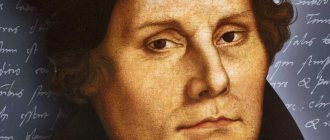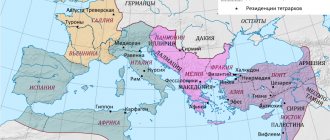| Head of the Colossus of Constantine (unknown sculptor, c. 312-325). Capitoline Museums, Rome |
Constantine I the Great
(
Flavius Valerius Constantine
) (+ 337), saint Equal to the Apostles, Emperor of Rome (306-337) Commemorated May 21
Constantine the Great was the son of Constantius Chlorus, ruler of the Western Roman Empire (Gaul and Britain), and Saint Helen Equal to the Apostles. Constantine's father did not persecute Christians, while in all other parts of the great empire they were subjected to severe persecution. At the request of Emperor Diocletian, in his youth (18 years old) he was taken from his parents as a hostage and lived at court in Nicomedia. When Diocletian abdicated the throne, Constantine returned to Gaul and was proclaimed emperor in 306 (after the death of Emperor Constantius).
He was encouraged to accept Christianity by his mother. His father, although he was a pagan, patronized Christians, seeing that Christians were faithful servants and honest citizens. At the court of Diocletian, at a time when he had not yet persecuted the Church, there were Christians in various positions, and Constantine had many occasions to ascertain their honesty and devotion to duty. Then he saw the horrors of persecution and the extraordinary firmness of Christ's confessors, and this also predisposed him in their favor. Subsequently, Constantine himself admitted that his stay at the court of Diocletian greatly contributed to his conversion to Christianity: “I was alienated from the hitherto rulers, he said, because I saw the savagery of their morals.”
By his nature, active, militant, accessible and generous to everyone, far-sighted and insightful, Constantine displays the traits of a world genius, and it was not in vain that he was chosen by God's Providence to carry out the greatest revolution in the empire and throughout the world.
During his reign, Emperor Constantine fought in particular against three enemies, and during this struggle he gradually but decisively leaned toward accepting the holy faith.
| Equal. Tsar Constantine the Great. Greek icon, XXI century) |
In 308, he happily emerged from the struggle with Emperor Maximian Herculus and hastened to express his gratitude to the deity with rich sacrifices in the temple of Apollo.
This revealed a dominant feature in the character of Constantine: although he still remained a pagan, he was a pious man and attributed the reason for his success to help from above. In 312, a new war broke out between Emperor Constantine and Caesar Maxentius, the son of Maximian. During this war, shortly before the decisive battle at midday, when the sun had already begun to lean towards the West, Constantine with his own eyes saw a luminous cross in the sky with the inscription: “By this (this) conquer” (in Greek: ἐν τούτῳ νίκα). At night, in a dream, the Lord appeared to him with the same sign of the cross and said that with this sign he would defeat the enemy. The next day, by order of Constantine, images of the holy cross were made on all the signs of his army.
Having defeated Maxentius, Constantine solemnly entered Rome and here in the square he ordered to erect his statue with a cross in his right hand and with the inscription: “With this saving banner I saved the city from the tyrant’s yoke.”
Constantine did not stay in Rome for long and went to Milan, most likely, at the beginning of 313. Licinius also arrived here. Here the marriage of Licinius to Constantine’s sister was celebrated, and their union was further strengthened. They stayed in Milan no longer than April. Here they drew up a legislative decree that determined the position of Christians in the empire. This document is known as the Edict of Milan of 313.
Meanwhile, the friendly relations between the emperors Constantine and Licinius gradually deteriorated and turned into open struggle. This struggle was to decide the fate of Christianity in the Roman Empire, because Licinius, suspecting Eastern Christians of greater attachment to Constantine, first began to oppress them, and then went over to open persecution of them, and Constantine clearly patronized Christians. Both emperors were preparing for a decisive struggle, each in accordance with his faith. Oracles predicted victory for Licinius, and Christians prayed for Constantine. God granted victory to Constantine in two battles, first at the Battle of Adrianople (322) on the European continent, and then at Chrysopolis (modern Yuskudar) in Asia Minor. Licinius was removed from power and eventually executed. Constantine became the sole ruler of the empire, and Christianity triumphed.
| Equal. Tsar Constantine. Mosaic in the Hagia Sophia in Constantinople (late 10th century) |
Emperor Constantine devoted his entire life to the good of the Church and did so much good to it that he earned the title of Equal-to-the-Apostles.
Since his time, government institutions, laws, and military service began to focus on the requirements that lie in Christianity. It can be indicated that the following measures and actions of Emperor Constantine in favor of Christianity, in addition to the mentioned edicts, are in order of time: he stopped pagan games (314), freed the clergy from civil duties and church lands from general taxes (313-315) , abolished execution by crucifixion and issued a strict law against the Jews who rebelled against the Church (315), allowed the freeing of slaves in churches without special formalities, which were very difficult in civil courts (316), prohibited private individuals from making sacrifices to idols and turn to fortune telling at home, leaving this rule only to society (319), ordered the celebration of Sunday throughout the empire (321), and, to protect Christian virgins, abolished the Roman laws against celibacy; granted the Church the right to receive property under wills, allowed Christians to occupy the highest government positions, ordered the construction of Christian churches and prohibited the introduction of imperial statues and images into them, according to the custom of pagan temples (325).
During the reign of Constantine, the former name of the city of Jerusalem was restored instead of the new one, Julius Capitolinus, given to it under the emperor Hadrian.
Most of all, Emperor Constantine encountered opposition in Rome, where the pagan party was strong. This opposition of the pagans was revealed especially during Constantine’s celebration of the 20th anniversary of his reign and cooled him towards the former capital of the state. His favorite city was Serdica (now Sofia), about which he said: “Serdica is my Rome.” Finally, he completely left Rome and began to rule from Serdica. It was there that the decision was made to found a new Christian capital of the empire [1]. It became the city of Byzantium on the banks of the Bosphorus, where the holy king invited Christian bishops to solemnly consecrate it, calling it Constantinople. Instead of pagan temples, Christian temples began to be erected in this new capital of the empire, and instead of statues of pagan gods - sacred images.
| Equal App. Kings Constantine and his mother Helen. Novgorod icon (XVII century) |
Emperor Constantine paid close attention to the unrest that was aroused in the Church by the Donatist schism and especially the heresy of Arius, and tried in every possible way to reconcile those divided.
One of the greatest merits of Constantine was the convening of the First Ecumenical Council in the city of Nicaea in 325. Constantine had many excellent qualities, but the murder in 326, first of his son Crispus, arranged by his stepmother Fausta, and then, when the son’s innocence became clear, of Fausta herself, shows him from the other side.
Devoted to the Church with all his soul, Constantine, however, according to the custom of that time, postponed accepting baptism until the last days of his life. When he felt the approach of death, he accepted this great sacrament with reverence and died peacefully during prayer on the day of Pentecost, May 21, 337.
Constantine died in Achiron, a suburb of Nicomedia, during preparations for the war with Persia; before his death, he pre-divided the Roman Empire between his three sons: Constantine II (reigned 337–340) received Britain, Spain and Gaul; Constantius II (ruled 337–361) received Egypt and Asia; Constans (reigned 337–350) received Africa, Italy and Pannonia, and after the death of his brother Constantine II in 340, the West was completely ceded to him. Illyricum, Armenia and Pontus went to two nephews of Constantine - Delmatius and Hannibalian. It cannot be said that such a division was far-sighted: immediately after the death of Constantine, almost all of his relatives were exterminated by the army, which wanted to protect the throne from new claimants. Clashes between the heirs continued until, in 350, only one emperor remained, Constantius II.
Life of Constantine the Great before his proclamation of the Edict of Milan
Constantine, called the Great for his outstanding historical services, was born during the era of persecution of the Church of Christ (presumably around 280-285). His father, Caesar Constantius Chlorus, was a ruler in Gaul and Britain. Mother, Elena, led a Christian life (she was later glorified as a saint).
Unlike other representatives of the highest titled nobility, Constantine’s father treated Christians with more than restraint. In the part of the empire that he led, there was no persecution of the Church, as in other areas.
After the death of Constantius Chlorus, in 306, Constantine, with the assistance of the army, was proclaimed emperor. He treated Christians no less tolerantly than his father. According to his characteristic way of thinking, he well understood that among them there were honest and valiant people, and that belonging to Christianity did not mean hostility towards the authorities.
Having ascended the throne, Constantine faced opposition from powerful opponents: Maximian and Maxentius. Guided by personal and political interests, he was forced to fight with them.
Having become the sole ruler of the Western part of the empire, in 313 Constantine issued an edict of toleration, which went down in history under the name “Milan”. According to this (exceptionally important) document, the activities of the Church ceased to be articulated as illegal and were no longer subject to prosecution. Of course, this did not mean that Christianity immediately became the state religion. At the same time, this fact marked the triumph of the highest justice: Christians received the hard-won right to profess their faith openly. In addition, Constantine prohibited execution by crucifixion and endowed the Church with special civil rights.
After he finally defeated Licinius, who was at war against him, in 324, his power spread throughout the entire territory of the Roman Empire. At the same time, the Edict of Milan spread throughout the territory.
According to solid legend, before one of the decisive battles, Constantine saw the sign of the Cross in the sky and at the same time the inscription: “hereby conquer.” After this incident, at night, in a dream vision, the Lord appeared to him and revealed that through this sign he would crush the enemy. The next day, by order of Constantine, the symbol seen was depicted on military banners (according to some sources, on shields). And indeed, by the Providence of God, the army of Constantine the Great defeated the enemy. Since then, this image has become one of the most striking symbols of Christ and His Sacrifice on the Cross.
short biography
Name: Flavius Valerius Aurelius Constantine, Constantine I, Constantine the Great
Years of life: February 27, 272 - May 22, 337
State: Roman Empire
Field of activity: Politics
Greatest Achievement: Was Emperor of the Roman Empire. Introduced Christianity, moved the capital and changed the name to Constantinople
Diocletian was the first ruler who absolute the power of the emperor in the Roman Empire.
He was able to achieve this by dividing power between two emperors, the Augusti, and their deputies, the Caesars, creating a tetrarchy.
But this form of power did not exist for long, a few years after the death of Diocletian, an emperor ascended the throne, defeated all contenders for the throne, united the fragmented empire and founded a new capital.
He became the son of Constantius I Chlorus (or Pale) Constantine.
Further activities
Having become a sovereign monarch, Constantine carried out a number of important reforms. Having rid the empire of the predominance of pagan cults, he moved the capital from the West to the East. This was in line with the strategic intentions. In addition, the formation of the new capital symbolized the beginning of a new historical stage in the life of the empire. The location chosen was the ancient city of Byzantium, located on the Bosphorus coast. It was seriously expanded and strengthened. The new capital was named “Constantinople”. Over time, Constantinople also turned into the center of Orthodox culture.
Despite the fact that Constantine himself was in no hurry to accept Holy Baptism, he patronized the Church in every possible way. We can say that under him, Christianity began to play a priority role not only in the religious sphere, but also in the political arena, for example, rallying and uniting the people.
On the initiative of Emperor Constantine and his mother, Queen Helena, the latter personally went to Jerusalem with the goal of finding the Holy Cross on which the Lord Jesus Christ was crucified. Sending the queen on the road, Constantine endowed her with the necessary powers and material resources. With the assistance of God, in 326 the Cross of the Lord was discovered.
In general, through the efforts of Constantine and Helena, holy places associated with the life and work of the Savior were freed from traces of idolatry, and Christian churches were erected on the most memorable of them.
Byzantium
With Constantine coming to power, a sense of stability returned to the country.
He considered that it was necessary to found a new capital of the empire and found a small city suitable for this - Byzantium, which was strategically conveniently located and could be easily defended from all sides.
To prepare the city, he brought artisans and resources from all over the empire. He rebuilt the walls, installed statues of great emperors on the avenues, and built churches and pagan temples.
This city was developed in a classical Roman manner, but at the same time it was inspired by the Christian god.
In 330 the city was named the capital of the empire.
The role of Emperor Constantine in the convocation and organization of the First Ecumenical Council
The spread of heresies, which began in the early days of the Church, during the era of persecution, did not stop even after Christianity breathed freely. The heresy of Arius, an Alexandrian presbyter, acquired particular significance during the reign of Emperor Constantine.
At one time, this shepherd, motivated by ambition, entered into a dispute with Bishop Alexander and slandered him, accusing him of perverting the teaching about God. Very quickly, from slanderous criticism, a false doctrine was formed, according to which the consubstantiality of the Son with the Father was denied, and the Son was recognized not as a generation, but as a creation of God the Father.
Despite the apparent obviousness of the absurdity of the new teaching, it soon spread beyond Alexandria. Supporters began to gather around Arius, including virgins, deacons, priests, and bishops. The situation became more tense the more the preachers of this blasphemy multiplied. Among other things, the sharp increase in the number of heretics was facilitated by the lack of clearly developed theological terminology.
To the Local Council convened in Alexandria, which condemned Arius and exposed his false teaching, the heretics responded with a Council in Bithynia, which recognized Arius as innocently convicted.
Emperor Constantine, having received news of the growing disputes, was greatly saddened and considered it his duty to intervene in the situation personally. Unrest in the Church worried him both as a sovereign and as a sympathizer of Christianity. And he sent Hosea of Corduba to Alexandria with a letter of exhortation. However, this measure did not bring the heretics to their senses. In addition to these internal difficulties, others were added.
And then, driven by the desire to resolve the growing problems in the Church, the king, on the advice of the bishops, decided to convene a Council. The heads of all Churches were ordered to come to Nicaea.
Thus, in 325 the First Ecumenical Council took place. He united 318 bishops. After lengthy discussions, the Council confirmed the consubstantiality of the Father and the Son, formulated the Creed (which was supplemented and finalized at the Second Ecumenical Council) and condemned the doctrine of the creation of the Son by the Father.
Arius and the bishops who refused to subscribe to the conciliar definition were sent into exile.
The last years of Constantine's reign
On July 5, 328, the emperor personally opened the “Bridge of Constantine” across the Danube at Sucidava in Dacia, which became the longest river bridge of antiquity. Its total length was 2437 meters, of which 1137 meters passed over the Danube. The width of the bridge was 5.7 meters, and the height above the river level was 10 meters. Constantine's plans included the return of Dacia, which was abandoned back in 271 under Emperor Aurelian.
In 332, Constantine fought a joint war with the Sarmatians against the Goths. The Visigoths, led by Ariaric, left Oium and began to advance into the territory of the Sarmatians in Dacia. The Sarmatians asked Constantine for help, and on April 20, 332, the Roman army under the leadership of his son Constantine II defeated the barbarians, destroying about 100,000 barbarians “by hunger and cold.” In 334, the Sarmatians staged a coup against their leaders and then Constantine began a war with the Sarmatians. Having defeated their troops, Constantine settled some of the survivors in Illyria as peasants, and took others into his army. The barbarians settled in certain lands, known as colons, became the prototype of the serfs, since they did not have the right to leave the land they cultivated. In 336 Constantine received the title Dacicus maximus.
After successes in Dacia, Constantine plans to go to war with Sasanian Persia. In 338, the Treaty of Nisibis ended and both countries prepared for war. Constantine writes a letter to Shikhinshah Shapur II, in which he talks about his patronage of Persian Christians and demands an end to the oppression that began after Rome adopted Christianity as the official religion. Constantine planned to be baptized in the Jordan River before entering Persian territory, but he fell ill in the spring of 337.
Apparently realizing his imminent death, Constantine secretly prepared a burial place for himself in the Temple of the Holy Apostles. But after Easter 337 he felt worse and went to Helenopolis to use the baths. At first, he was treated in the baths of Nicomedia, then resorted to the hot springs of Drepan, after which he settled in his capital villa Ankyrona, where he called several Arian bishops, including Eusebius of Nicomedia, to be baptized. Having gathered the bishops, he admitted that he dreamed of being baptized in the waters of the Jordan, but by the will of God he accepted it here. But, feeling worse, Constantine ordered to be transported to Nicomedia where he was baptized by Eusebius of Nicomedia on May 22, 337. After his death, Constantine the Great was buried in the Temple of the Holy Apostles.
The activities of Emperor Constantine after the Ecumenical Council
Despite the decisions made by the fathers of the Council, the Arian ferment did not stop. Moreover, on the basis of this teaching, various directions of heresy were determined: radical and more moderate.
In 328, Alexander of Alexandria died and Athanasius the Great took the see of Alexandria. A faithful supporter of the purity of Orthodox ideas, a man of holy life, he waged an irreconcilable struggle with Arianism. Unable to stop Athanasius with dogmatic arguments, the champions of heretics used the old proven method and began to intrigue. They began to accuse the saint: allegedly, having burst into the temple, he knocked over the cup with the Holy Blood; then he allegedly sent a box of gold to a certain usurper Philumen.
In 332, Athanasius was summoned to the emperor. However, after a conversation with the saint, Constantine spoke kindly about him.
In 335, associated with the approach of the thirtieth anniversary of Constantine's reign and the completion of the construction of the basilica over the Holy Sepulcher, the emperor summoned bishops to Jerusalem. However, before this they had to gather in Tire for the Council. The Tsar wanted peace to finally be established at this Council. There, according to the inspiration of Constantine, Athanasius the Great was also to appear.
At this Council, a new accusation was brought against him, somewhat strange, as if he, having killed Bishop Arseny, left his hand for sorcery. Having left Tire, Athanasius reached Constantinople, achieved a meeting with Constantine and pointed out to him the insignificance of the charges being raised.
Unfortunately, during the reign of Constantine, Arianism was never exterminated.
At the end of his earthly life, the emperor received Holy Baptism. In 337, on the day of Pentecost, he quietly departed to the Lord.
From him we have received: the Edict of Milan on the freedom of the Christian faith, the Epistle to Bishop Alexander and the presbyter Arius, the Epistle to the Alexandrian Church against Arius, the Speech of Emperor Constantine to the Holy Council, the second Speech of Emperor Constantine to the Holy Council, an excerpt from an admonishing speech to the bishops before their departure from Nicaea after the council, Epistle from Nicaea to the bishops who were not present at the council, Epistle to the Nicodemuses against Eusebius and Theognis, etc.
Saint Helena
All ancient authors were unanimous that the emperor's mother was a girl from a simple family. The story of its origin goes back to the speech of Bishop Ambrose, delivered in 395 at the funeral of Emperor Theodosius. In it he talks about Helen's rise from low status to Augusta.
She is often referred to as a tavern maid or the tavern owner's daughter. Researcher Timothy Barnes analyzes word usage in Ambrose's speech and comes to the conclusion that Helen was the daughter of the owner of a mansio - a hotel that was intended for officials of the empire. The owner of such a hotel had a fairly high social status.
The question of Elena's marriage is also in question. Already in ancient times, authors opposed to the emperor emphasized his artistry. The 5th century church historian Philostorgius spoke disparagingly about Helen. The 6th century historian Zosimus called Constantine the fruit of an illegal union and contrasted him with the children of Constantius and his other wife Theodora. Both authors who lived later repeat the words of the historian Eunapius, who was hostile to Constantine. Another author, Jerome of Stridon, also calls Helen the concubine of Constantius.
Elena's image on a coin. (wikimedia.com)
Some researchers consider her to be a simple concubine of Constantius Chlorus, based on the low social status of Constantine’s mother. While Constantius Chlorus was an aristocrat from Dalmatia. But they admit that she was his legal wife.
Constantius and Helena met around 272. At that time, Emperor Aurelian was trying to unite the empire under his rule, and Constantius was an army officer. Their son Konstantin was born on February 27 (the exact year is unknown). A later eulogy for Constantine stated that he was born to his father when he was in the prime of his youth.
After some time, Constantius was forced to divorce Helen in order to marry Theodora, the stepdaughter of the new Augustus Maximian. In 293, Constantius was proclaimed Caesar, a title held by two “junior” emperors.
The marriage of Constantius and Theodora produced three sons and three daughters, none of whom had reached adulthood by 306, when their father died. Constantine's half-sisters later married influential people in the empire, and his half-brothers received government positions.
Prayer to Equal-to-the-Apostles Tsar Constantine and Queen Helena
About the wonderful and all-praised king, the holy Equal-to-the-Apostles Constantine and Helen! To you, as a warm intercessor, we offer our unworthy prayers, for you have great boldness towards the Lord. Ask Him for peace for the Church and prosperity for the whole world. Wisdom for the ruler, care for the flock for the shepherd, humility for the flock, desired repose for the elder, strength for the husband, beauty for the wife, purity for the virgin, obedience for the child, Christian education for the baby, healing for the sick, reconciliation for the offended, patience for the offended, fear of God for the offended. To those who come to this temple and pray in it, a holy blessing and everything useful for each request, let us praise and sing the Benefactor of all God in the Trinity of the glorified Father and the Son and the Holy Spirit, now and ever, and unto the ages of ages. Amen.
Decoding How the Roman Empire Became Christian
Contents of the second lecture from the course “History of Orthodox Culture”
In 312 AD, the Roman Emperor Constantine fought for the capital of the empire, the Eternal City - Rome. The entire empire, which had recently been so successfully restored by Emperor Diocletian, was in the throes of civil war. The beautiful idea of collective leadership of the state from two Augusti and two Caesars, replaced every 20 years, turned out to be utopian. As soon as Diocletian voluntarily retired, his heirs and co-rulers immediately quarreled and began to divide power. In the western part of the empire, two sons of the former Augusti competed: 40-year-old Constantine, followed by the legions of Britain and Gaul, and Maxentius, who owned Italy and Africa. Historians, citing the words of Constantine himself, say that before the decisive battle for Rome, the emperor (at that time a fan of the solar cult, like many military people in the Roman Empire) saw a sign in the sky - a sign in the form of a solar cross. Very superstitious, like all Romans of that era, the emperor interpreted this as a sign of patronage from the Christian God: it was the cross that was associated with Christianity at that time. The monogram, seen by the emperor in the form of the letters “chi” and “rho” (☧), was depicted on the banners of Constantine, on the shields of his soldiers, and after the glorious victory over Emperor Maxentius and the capture of Rome, it became a kind of coat of arms of the Roman Empire: it can be seen on many sarcophagi, buildings and decorations of churches of that time and future, already Christian centuries.
It should be noted that Christianity under Constantine did not become the official state religion at all: both Constantine himself and his numerous imitators from among the military and civilian elite, although they converted, that is, believed in Christ, were in no hurry to be baptized and, out of duty, often participated in pagan rituals. And the majority of the empire's population, of course, at that time were not Christians. But Christianity had already become a religion patronized by state power, which meant a lot in the Roman Empire. Moreover, the old pagan religion rested solely on state status, since the Roman emperor was also the chief priest, the great pontiff (and in Greek, a bishop). And as soon as the emperor converted to another faith, the official Roman religious tradition very quickly began to fade away.
But Constantine himself, and other military leaders and politicians of that time, did not immediately accept baptism. This is very important to note: baptism was perceived at that time as a seal, final entry into the ranks of the Church of Christ, which obligated one to conform to a very high standard of Christian life. And a baptized person could not easily participate in wars, approve death sentences, which at that time mainly consisted of Roman legislation, so people engaged in government activities, including the emperors themselves, postponed baptism until their deathbed, remaining in the status of catechumens Catechumens are people who did not accept baptism.. But this does not mean at all that they were not believers. Both Constantine the Great himself and all his successors were zealous Christians, although they could not eradicate centuries-old pagan traditions overnight, especially since military victories and the glory of the Roman state were associated with these traditions (it is no coincidence that the statue of the goddess Victoria adorned the Roman Senate, and just around it subsequently took place a dramatic struggle between Christian emperors and Roman senators who still remained faithful to the old tradition).
The only exception from this series of Christian emperors, successors of Constantine the Great, was his nephew Julian, who, in general, was not planned to be an emperor - he was baptized in his youth, and a spiritual career was being prepared for him. But Julian became interested in the ancient classics and hated Christianity with every fiber of his soul, for which he later received the nickname “apostate,” that is, an apostate. It is characteristic that Julian tried to create something like a pagan alternative to the Christian church with his theology based on the solar cult, on the veneration of the god Helios. He introduced a hierarchy of priesthood, temple worship with chants, established something like a moral code of the priest (which caused great discontent among the pagan clergy), and developed a sophisticated theology. But the idea of such a pagan church turned out to be incompatible with the traditions on which ancient pagan culture relied. And the pagans themselves ridiculed Julian as an incomprehensible eccentric. His adventurous Persian war, which he began following the example of his beloved Alexander the Great, was, one might say, a gesture of despair. There, in Persia, he found his death - as they say, throwing a handful of bloody earth towards Helios (that is, the sun) and uttering the phrase “You have won, Galilean!” - thereby, as it were, recognizing the victory of Christianity over paganism. So by the end of the 4th century, after the failure of this last pagan reaction, Christianity actually became the official religion. That is, despite the fact that the law guarantees freedom of faith, the emperors themselves are already Christians, officials were Christians, and Christianity becomes mandatory for public life. You can, of course, remain a pagan at the same time, but in such a way that no one notices. All pagan sacrifices and rituals are prohibited, the propaganda of paganism is prohibited, pagan temples are closed everywhere, and subsequently Christianity is even introduced into the legal system of the empire. This is very important, because the emperors who became Christians faced a very difficult task: they had to somehow transform the Roman Empire, a cruel and harsh state, into a state living according to the commandments of Christ.
This task is not easy. Strictly speaking, Christianity generally prohibits the use of coercion, including legislative coercion, in order to make a person pious. And although Constantine the Great himself perceived Christianity as a law, that is, as a system that is not allowed to be violated, this law in Christianity is precisely spiritual. This is not the Law of Moses, the violation of which was followed by quite tangible criminal punishment, these are precisely moral norms that a believer must fulfill voluntarily. And this is one of the main principles of Christian teaching, for it is in the will that human sin is rooted. If this sin is not corrected within a person, in his own will, then it cannot be eradicated. Nevertheless, the state has no other levers other than legislative ones, so the emperors gradually began to carry out a kind of Christianization of Roman legislation.
In general, Christian teaching has made a real revolution in the field of religion, law, which is closely related to religion, since if it is based on faith in the truth of the principles that are embedded in it, then it is much more viable than abstract law based on some form of social contract . In Christianity, for the first time, the concept of grace (Greek “charisma”) was placed at the forefront, that is, the relationship between God and man was built on a completely free basis. God not only does not need anything from people - even pagan philosophers agreed with this - God sacrifices himself to people, since the crucified Jesus Christ is the Son of God. And every Christian service, the Eucharist, is a reminder of this sacrifice.
The death of Christ, God and the Son of God, given over to the most humiliating and most cruel execution that humanity could invent (doctors can explain that crucifixion is when a person dies not from wounds, but from slow painful suffocation), became at the same time the final break agreement between God and man that was made in the Old Testament. In the Old Testament (Hebrew “barit”, that is, an agreement, a contract between God and his beloved people, Israel), people seem to say: we honor you, but you help us. The New Testament is conceived as a mutual exchange of selfless gifts of love. God, who loved humanity to such an extent that he gave his own Son to an innocent slaughter for the atonement of human sins, gives people his grace both here on earth and in eternal life. But what does He require from man? A person is expected to reciprocate love for God, and it is the fruits of this love that are good deeds and the so-called fear of God, which is not at all similar to the fear of a formidable boss who will punish for disobedience. It resembles a son's fear of offending his father, a mother's fear for her child. And it is this fear - of being unworthy, the fear of imperfection - that stops a person from committing sins. The consequence of this fear is not at all timid humility - on the contrary, it moves a person to a zealous pursuit of an ideal that seemed unattainable.
In general, Christianity is a religion of maximalists. It requires complete dedication, renunciation of oneself, and this is the most difficult thing that is expected of a person - overcoming selfishness and any form of limitation: national, cultural, state. This is a religion of fiery love for God, which is expressed in love for neighbors, for those distant, selfless and selfless, above which there is no virtue at all, no order, no piety, no wisdom. All these values are lower than love. You can call Christianity precisely the religion of love. And despite the fact that Aristotle already taught that any society rests on love, the kind of love that Christianity expects from its followers is extremely difficult to demand from people.
The question is: how can a state be built on such principles? The already mentioned Emperor Julian the Apostate ironically reproached Christians: what a wonderful demand you have - sell your property and give alms. Or maybe something more suitable for society? Well, if everyone sells, he says, then who will buy? And in general, if they begin to fulfill your commandments, there will be no state, no city, and not a single normal household left. Everyone will turn into some kind of strange philosophers, incapable of practical life. But in reality, we see that Christianity is not only not rejected by Roman society (in principle, quite pragmatic), but, on the contrary, over the course of some two or three centuries, with colossal interest, society begins to absorb Christianity, and in some At the moment it becomes, one might say, the only generally accepted system of moral values.
Here is a typical example: in the code of laws of the Roman Empire, compiled under Theodosius II in 438, an entire section is devoted to the laws of the Church and religion, but it constitutes the last, 16th book of the Code of Theodosius. And a hundred years later, in the 6th century, in the Justinian Code, the ecclesiastical section was placed in the very first book, and the very first chapter of this legislative code is called “On the Trinity and the Catholic Faith.” Here it is worth talking about what Catholicism is, for the word “catholikon”, or, as this word is usually applied to the Church, catholici iglesia, literally means “universal”. In Slavic it is translated as “cathedral”. The cathedral church, that is, the church gathered from all religious communities of the empire. It is opposed by those communities that, for one reason or another, break with the fullness of the church body and go into schism. Thus, the Catholic faith is the faith of the whole Church, the universal faith. And in this sense, the word “Catholic” is a complete synonym for the word “Orthodox”, for Orthodoxy (orthodoxy, true faith, true teaching) is a dogmatically correct system of religious worldview. And the very correctness of the dogma was assessed precisely through its recognition by the entire church, that is, by its universality, universality. Usually dogmas were approved at Ecumenical Councils, although not necessarily. So, in imperial legislation since the 4th century it has already been written that no one dares publicly speak out against the Catholic faith. And Christianity becomes not just an official religion, but the state takes upon itself concern for the purity of faith and, in general, for the unity of the Church. This also must be perceived in the context of the old Roman traditions, where the state was always thought of as not just a secular, but partly a religious structure, for the Roman Empire, created by Caesar and Augustus, bore a very clear imprint of sacredness: everything that was connected with power, was sacralized. This tradition continued into the Byzantine era. Sometimes it confuses us a little, but we should remember that the famous halos that now adorn the icons of all the saints were originally an imperial attribute, and it is around the imperial portraits that this solar radiation appears. In our time, when the state and the church are already everywhere separated, we have almost forgotten that until the twentieth century it was considered completely unnatural for the state to remove itself from religious politics.
In ancient times, when all power was sacralized and the ruler and the high priest often acted as one person, it was quite natural that emperors were interested in religion and defended it. The Roman emperors, who were also supreme pontiffs, having become Christians, abandoned this epithet of theirs. And there was even a proposal from society: couldn’t they lead the entire Christian church? But Emperor Constantine categorically refused to become a bishop. And from that time on, an unprecedented and unique kind of dual power was established in the Roman Empire, when the state and the church began to dominate society on equal terms. But the state rules in the traditional way - through policies, laws and all kinds of institutions that enforce piety within the limits of the law - and religion, which in principle cannot use violence, acts through exhortation and relies on the good will of believers. The logic is simple: the main task of both the state and the Church is the good of society. And if the church is unworthy, then God, who is capable of giving a person good, evil, blessings, and difficult trials, may be angry with the Christian people, and therefore it is in the interests of the state itself to ensure that the church is holy and united.
And in this system, when the state is already beginning to patronize the Church and take care of the spread of Christianity throughout society, the pagans are already being persecuted. But, it is true, the pagans resist rather sluggishly and do not perform feats of martyrdom, so paganism, in principle, disappears from the scene, but goes into a kind of intellectual opposition, where it simmers for many centuries and will manifest itself in due time.
The paradox is that Christianity is, in principle, an apolitical religion. More precisely, politics in this religion plays a very significant role: after all, Christ was executed precisely for political reasons. But this policy is of a special kind. Jesus Christ is indeed the King, but His kingdom, in His own words, is not of this world, that is, it has nothing in common with the political institutions we are accustomed to. On the contrary, it opposes them, just as legalized violence, the main attribute of the state, opposes conviction and faith. The main idea of Christianity, which runs like a red thread throughout the entire New Testament, is that a person cannot be forced to righteousness, it can only be the result of a voluntary striving for the highest good, the fruit of pure love for God. And if fear of the law or Pharisaic formalism is mixed into this, then this does not yet lead a person to true salvation. But what then is the role of the state in such a system? Does this mean that it is not needed at all? Indeed, a society of saints (and holiness, as we understand, for a Christian is a normal state) does not need a state.
But where is this society of saints? Neither during the times of the first Christian communities, which were tiny islands in a pagan sea, nor during the times of the outwardly Christian, but internally for the most part still dilapidated and far from the New Testament ideal of the Roman Empire, no one was deceived (as, by the way, Lev Nikolaevich did a hundred years ago Tolstoy) that the elimination of violence will open the way for good. Not at all - it will open the way to evil. And therefore, even the apostles, who lived under the rule of emperors who were far from sympathetic to them, understood perfectly well that state power precisely blocks the path to atrocities. Therefore, when the Apostle Peter says “... be subject to every human authority,” and the Apostle Paul says “let every soul be subject to the higher authorities” (in Church Slavonic - “to the powers that be”), there is no ingratiation at all in this before the powers that be of this world, since further comes the explanation: rulers are sent from God to punish criminals, and every power, every order is established by God to intimidate evildoers. This is very important. The great mission to which a Christian is called does not mean that the majority of people are ready for the law to be abolished. But at the same time, a Christian is always free. He obeys the authorities, but not as a slave of the king, but as a servant of God, and if he obeys the law, it is not out of fear, but out of conscience. Therefore, a two-story system arises, in which on the first floor of the law coercion is still permissible, keeping a person from falling into a bestial state, and the second level is the stage of grace, new perfection, which requires the elimination of the state. The church, the clergy, and the law of love operate here.
But then history shows us how difficult it turned out to be to realize Christian ideals in reality, especially in late antique reality, deeply imbued with pagan traditions. Yes, in the first centuries everyone became interested in Christianity: in the 4th, 5th, and 6th centuries, temples appeared throughout the empire, the model for which, by the way, was the former buildings of the imperial cult, the so-called basilicas - these are some kind of such clubs, clubs of admirers of the emperor - and famous The apses we know from our temples are where a huge imperial statue once stood. Deserts and cities are filled with monks - people who, in the conditions of the end of persecution and the widespread spread of Christianity, begin to look for a special ascetic life in order to experience the truth of their faith, their love. Indeed, in the new conditions, many people are converting to Christianity not because they sincerely believe in Christ, but simply because this is a general trend and it is now convenient and profitable. Complex theological issues begin to be discussed in markets, in taverns, in squares and sometimes become the cause (if not the pretext) of mass unrest, bloody clashes with troops trying to calm the raging crowd. But how far all this is from what is said in the New Testament, from the teachings of Christ.
However, this cannot be said that there has been no progress. Firstly, imperial legislation is seriously changing. Slavery is gradually being eliminated. And the equality of women and men is also one of the greatest achievements of Christianity, since in this religious tradition a woman is elevated to a very high level, for the Lord Jesus Christ himself was born of the Virgin Mary and it was through a woman that humanity was awarded salvation. This was seen as atonement for Eve’s sin, because earlier, in ancient tradition, it was believed that Eve’s sin cast a kind of spell on the entire female race. And now, through the Woman, through the Virgin Mary, the human race is saved, and there is no reason for treating women as second-class creatures. But along with this, Emperor Constantine begins to strengthen the family, because the equality of women in the conditions of a fairly free, loose Roman marriage leads to very undesirable consequences: women, receiving property and the opportunity to dispose of their inheritance, very often kick out their husbands, and here the emperor comes to the aid of the institution family and establishes strict prohibitions on divorce. In the Christian world they operated right up to the twentieth century, and in the Catholic world they still exist. And as you know, in the Catholic tradition, a murderer can be forgiven, but a divorced person remains excommunicated until the end of his days, outside the Church. Divorce becomes an unthinkable event, and the family becomes the main institution of Roman society.
The Church is emerging as a powerful organization, which, on the whole, despite all the excesses that have occurred, still manages to maintain independence from the state. This is also a very important aspect. In any case, church canons, the rules on which internal church life is based (and violation of which was punished, including by the state, which considered the canons as law), categorically prohibited and prohibit the interference of secular authorities at any level in the election of bishops, in the decision of doctrinal issues and other internal church problems.
The structure of the Church itself is a very curious fusion of very different traditions. There are elements of ancient democracy here, since all church positions are elective; Eastern despotism, since the bishop is the absolute ruler in his see; there are elements of collegiality, since the highest authority in the Church is the council of bishops, the council of equals; but there is also monarchical unity of command, since the bishop is the lifelong ruler and representative of the local church, the head of the bishops subordinate to him. Thus, the church structure organically connects elements of both the network structure and the vertical hierarchy. By the way, the word “hierarchy” itself means “hierarchy.” This allowed the Church to survive full-scale persecution by the Roman state, to survive internal squabbles and disagreements, and this is one of the guarantees that the Church, in fact, still exists in the forms in which it took shape in the 4th century. But the most important thing that allows the Church to remain almost unchanged is the strictest system of internal control, control over doctrine and internal discipline.
The first, that is, doctrine, is protected by the so-called dogmas - principles of faith that were prescribed as problematic issues matured and their collective, sometimes very dramatic, resolution and unraveling in the course of theological discussions. As a result, the solutions were recorded - usually in the form of formulas. The key and foundation of these formulas is the so-called Creed, that is, the short formula on which the Christian faith is based. Subsequently, this symbol was supplemented by definitions of faith and other dogmatic formulas, and the state stood guard over these formulas, since after the Ecumenical Council developed and approved them, their violation or criticism was considered a state crime, and people who went against the Church were considered as public dangerous elements and were subjected to exile and other repressive measures precisely as state criminals. Let us note: not for one’s conviction, but for one’s, if you like, pride, for one’s refusal to listen to the opinion of the majority. And this is also very important, since the state was not interested in the inner world, the inner beliefs of a person at all. That is, one cannot call Roman society of this era totalitarian. But all public forms of expressing one’s disagreement with the Catholic faith were prohibited, since this was considered a source of unrest, riots, and a threat to public order. And such persons, the so-called heretics (in Greek this word means “preferring”, “choosing”), that is, putting themselves and their opinion above the council decision, were subjected first of all to church punishment - but church punishment can only be reduced to excommunication and the so-called anathema (anathema is the highest form of excommunication, that is, a certain postponement of the trial of a person until the Last Judgment), but they also experienced repression from the law. Repressions that did not include the death penalty at all. This also needs to be borne in mind, since what we usually understand as punishment for heretics (that is, all those medieval auto-da-fé, executions, torture and other forms of violence) was categorically not allowed in this early Christian era. Moreover, often the heretics themselves received forgiveness, and in the event of their sincere repentance, they were completely reunited with the Church.
As for maintaining discipline, that is, what is regulated by church canons (immoral behavior of the clergy, bribery, that is, the sale of church positions, theft, other abuses), the state was called upon to maintain this church discipline, since the Church itself does not have a punitive mechanism. And if a person has already lost his conscience so much that he is not afraid of church penance, that is, church punishment, which by definition can only be voluntary (penance cannot be imposed by force), such a person was handed over to the civil authorities and he was already subjected to appropriate punishments for breaking the law. Thus, the Church and the state formed a unity.
In short, the Church prayed for the state, educated the people, and the state protected these very people from villains (internal and external), and at the same time protected the Church itself from unrest and moral decay and protected by law the norms developed by the Church itself. This is the famous symphony or symphony, that is, a system of agreement, consonant and harmonious singing, the action of two social mechanisms (political in the person of the state and religious in the person of the clergy), which lead a person, according to the preamble to the sixth novel of Emperor Justinian, to achieve all, whatever there is, good. And this is also a very important principle, since they often talk about the separation of the state and the Church as some kind of innovation. So, precisely the main principle of the religious system that developed in the Roman Empire in the Christian era, that is, in the era of the Ecumenical Councils, in the IV, V, VI centuries, was the system according to which the church and the state were completely independent of each other institutes. Institutions that did not have the right to interfere in each other's affairs: the Church did not have the right to appoint emperors or contribute to political struggles, the state did not have the right to interfere in church life, emperors did not have the ability to appoint bishops or patriarchs. But these institutions nevertheless performed the same task, and their service was thought of as a metaphor for singing in a choir. This is, in fact, the word “symphony” that Justinian uses, “consonant singing,” which means that everyone leads his own part, but if he is out of tune, then the result is not achieved. They can falsify in the following way: the state - violating the principle of justice, and the Church - violating the principle of true, correct faith, that is, orthodoxy, and moral order, that is, canonical discipline. And it was on this principle that the creation of that large socio-political building began, which can conventionally be called the project of Constantine and the goal of which was to build a Christian state.









